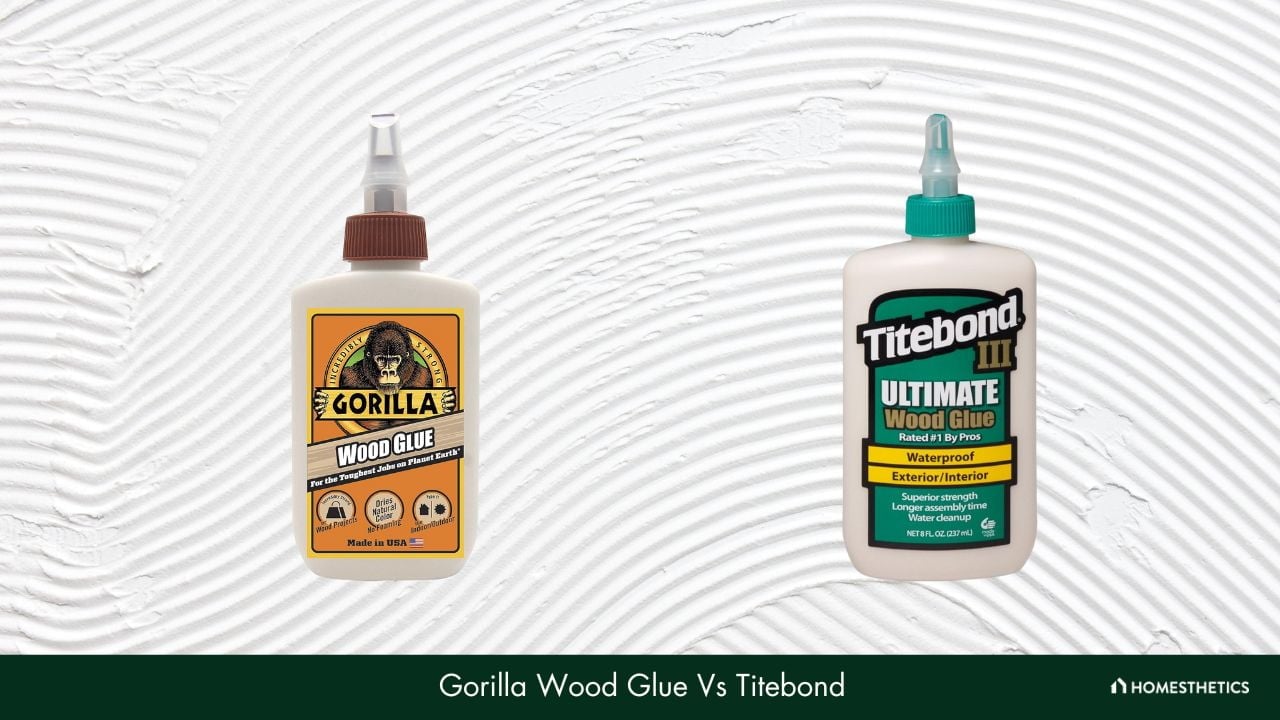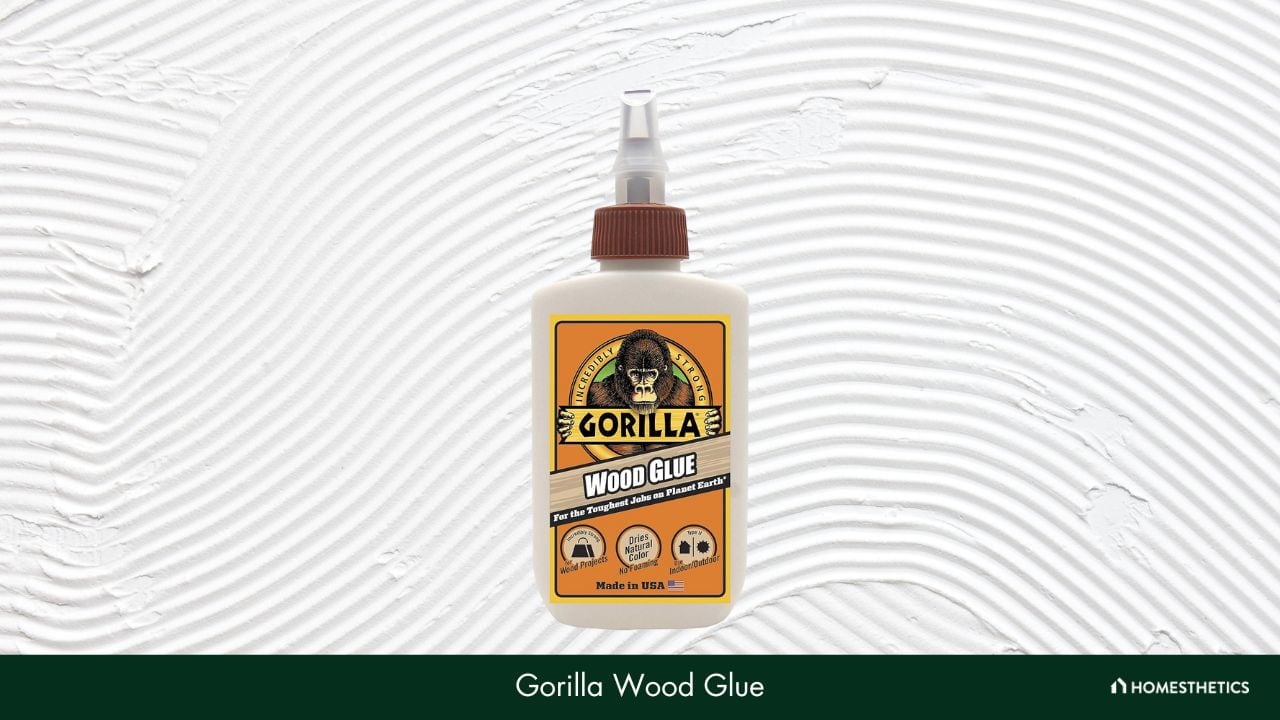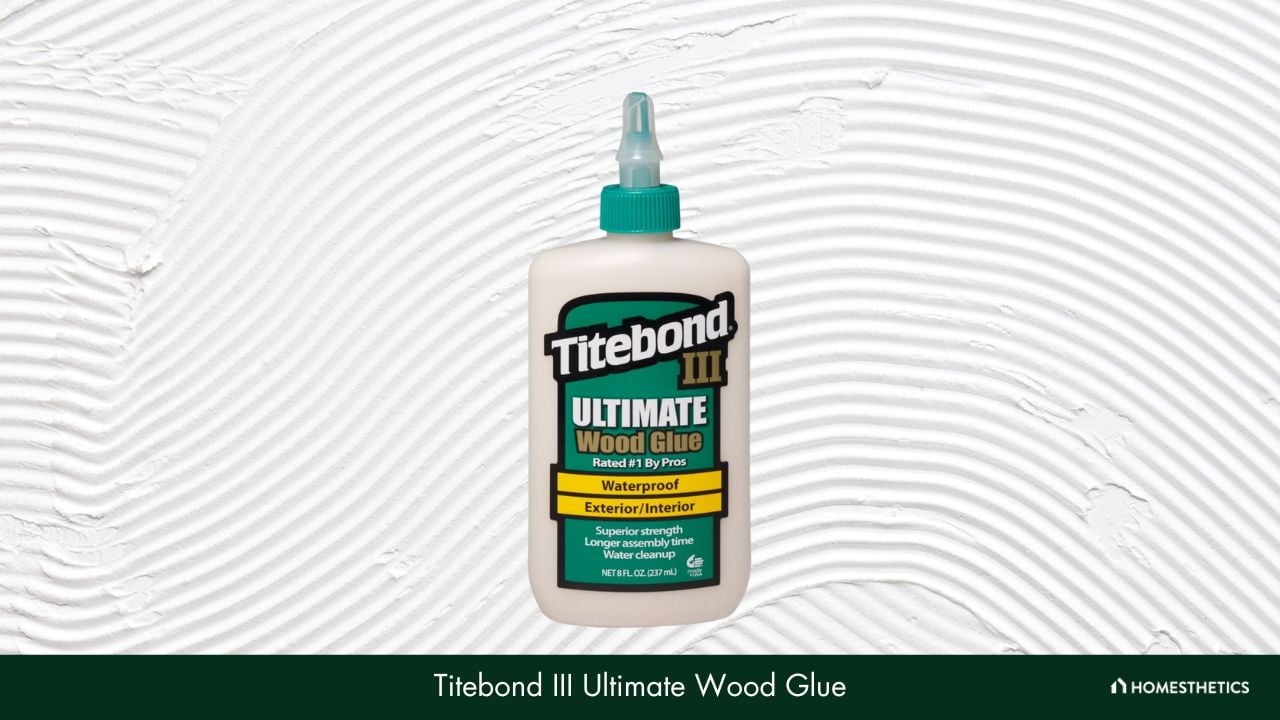It’s 2022, and we have a variety of wood glues in the market, and some of them are stronger than the wood itself!

Specialized glues for various repair tasks have recently cropped up, so if you’re looking to do some joinery work, you could look into using wood glue instead of clunky tools. It may sound like a far-fetched dream, but you’ll be surprised at just how effective an adhesive can be!
But, there are many brands available in the market, so how do you figure out which one to get? After a lot of research, we narrowed it down to the Gorilla wood glue and the adhesive from Titebond, which are the leading products in this field, in our opinion.
So, without further ado, let’s jump into this guide on Gorilla wood glue vs. Titebond, and let’s see which one is the better pick of the two!
1. Gorilla Glue
First, let’s look at this wood glue from Gorilla, which is multipurpose and can be used on different kinds of wood. It is ideal for soft or hardwood surfaces and natural wood composites. Plus, Gorilla is a reputed American company known for making quality products, and this glue is no different!
This wood glue is also suitable for DIY projects and is one of the most popular products available in the field of wood glues. Interestingly, it looks white when you look at it in the bottle, though it has a slightly deeper shade when it dries.
Moreover, Gorilla wood glue is a PVA, water-based glue. As such, it is easy to use and fast-acting, taking only half an hour to clamp and one day to cure. It is a user-friendly adhesive, and you also have the option of sanding off extra glue that might have spilled over onto the surface of where you were working.
Another fun fact about this wood glue is that it matches type ii ANSI and HVPA guidelines. This means that it's a breeze to use the glue outdoors since it's water-resistant and unaffected by mold. In addition to that, it doesn’t contain any added dyes, making it relatively safe.
What’s more, it’s suitable to use around food items and in the kitchen since it has been approved by the FDA.
Steps to Use
Step 1
Ensure that the surfaces you need to glue together are clean and dry. Also, make sure that they’re evenly cut and free from dust specks.
Step 2
Give the gluing process a trial run before applying the glue. Hold the pieces together and mark out how you want them to stick.
Step 3
Next, you have to add just the perfect amount of glue to the wood surface. This is probably the most crucial step since using too little glue will not provide a strong bond. However, applying too much glue might make things messy and tedious.
Step 4
In order to achieve an even distribution of glue, squirt a bit onto one spot and use a glue brush to spread it.
Why Did We Like It?
First off, Gorilla Wood Glue is easy to clean up if there’s an accidental spill. All you need is water and a washcloth, and you’re good to go. We also like how the glue is ultra-non-toxic and, thus, safe for people of all ages to use. So, if your children need to use it, there’s nothing to worry about!
Another remarkable fact about this product is that it doesn’t corrode or lose its adhesion even if exposed to sunlight or rain. So, we can say that the gorilla wood glue is waterproof! In addition to that, it can withstand both hot and dry weather and thus, is heat resistant.
We also liked how it expanded once used, making it strong and long-lasting.
What Could’ve Been Better
Despite all the advantages of the gorilla wood glue, we did, however, feel that it isn't as durable. Sometimes it dries up in the bottle itself if it hasn’t been used for an extended period of time. A probable reason for this could be the fast curing time of the glue, which kickstarts the drying procedure the moment it's exposed to any air.
Another thing the manufacturers could work on is the fact that this product does not work as efficiently with projects that require gaps to be filled.
Important Points To Be Kept In Mind
- The glue can’t be used for heavy-duty projects with a structural focus (like load-bearing) but can be used to reinforce mechanical fasteners.
- The glue is to be strictly used with wood and can’t be employed to stick plastic together.
- Since Gorilla Wood Glue is PVA-based, it doesn’t foam.
- It comes packaged in an attractive bottle with a nozzle that prevents excess glue from squirting out.
2. Titebond Glue
The other wood glue on our list is this one from Titebond, which is well known for its outstanding results when it comes to heavy-duty woodworking projects.
One of its most distinctive features is that it takes very little time to set. It needs one hour to clamp, which is exceptional, considering that it can pull off heavy-duty activities seamlessly. Titebond also adheres to type i ANSI and HPVA specifications which means it has superior resistance to water.
Titebond, too, has been approved by the FDA when it comes to indirect contact with food, and it’s relatively non-toxic as well. This is a helpful feature to have in case children come in contact with the glue.
Additionally, if you’re a messy worker and tend to glue yourself while working, fear not! Titebond can be easily washed off clothes when it still hasn’t dried up. This is important because Titebond isn’t a transparent glue- it looks yellow while in the bottle but turns to a brownish color post-use. This factor is also quite thoughtful- due to its brown finish, it blends right in with the wood.
Another fun fact about this product is that it is PVA glue, and thus, it doesn’t expand or foam. As a result, Titebond provides better adhesion than other kinds of polyurethane glues available in the market.
Steps To Use
Step 1
Make sure that the wood surface is clean before you begin working with the glue. A portable band saw may be used to make the edges clean and sharp. We recommend against using a handsaw since that leads to uneven edges, which create issues when you try using the glue.
Step 2
Next, it is imperative to ensure that the wood contains a moisture content of less than 6-8%. Additionally, the humidity of the workspace also needs to be below 50% for optimum results.
Step 3
Once the preceding steps are followed, the glue is ready to be applied. Take care to apply just the amount necessary- not too much and not too less. Applying excessive glue will result in the adhesive spilling over and creating a mess, whereas scarce application will result in a weak bond.
Step 4
Once the glue has been squeezed out onto the surface, it must be spread as evenly as possible with a glue brush.
Step 5
Lastly, hold the newly glued surfaces together using a clamp, and make sure to apply just the right amount of pressure. The glue might ooze out from the joining point if you press too hard. Conversely, a lack of pressure will lead to a bond that might break.
Why Did We Like It?
For starters, we liked how the setting time of this glue is minimal, which also means it takes significantly less time to clamp. Titebond wood glue is also solvent-resistant and thus, can be used pretty easily outside.
A highlight of using Titebond glue to bind your wooden items together is that the bond produced by the adhesive is stronger than the wood itself! Moreover, it’s a piece of cake to clean up any extra spillage on the wood- it just needs to be sanded out. You can, additionally, use water to clean up any remaining mess.
What Could’ve Been Better
To our dismay, though the glue makes pretty strong bonds, it cannot be used in cases where a lot of loads is to be born or structural joining is needed to be done. Moreover, one must take care of the conditions under which they are storing the glue. If kept at a very low temperature, the glue begins to thicken.
We also ran into another problem while using this adhesive. Right around the glue joint surface, we noticed a stain. This marred the look of our project significantly and was rather disappointing.
Important Points To Be Kept In Mind
- In case the glue gets on your clothes, dampen the area immediately and wipe it off while it’s wet.
- Ensure that the moisture level doesn’t go above 10%.
How are the Wood Glues Similar to Each Other?
1. PVA-Based
The major similarity between the two wood glues is that both are used for wood-to-wood adhesion and are PVA-based. This means that they don’t foam or make the bond weaker on application.
2. Waiting Time
In addition to that, the waiting time for both glues is similar. You have to wait 24 hours before you can safely test the strength of the bond.
3. Reaction To Low Temperatures
Another likelihood between both the products is that none of them react well to low temperatures and might become ineffective if exposed to a cold environment.
How are the Wood Glues Different from Each Other?
1. Time Taken To Create Bonds
One of the key differences between the products is that the Gorilla wood glue takes longer to create bonds. Whereas, Titebond sticks almost instantly upon application and takes far less time.
2. Scope Of Use
Apart from that, the scope of use of both types of glue also differs from each other. Titebond works most effectively with grain surfaces, and Gorilla Glue performs well on surfaces that are cross-grained.
3. Color
Moreover, as we mentioned above, Titebond tends to leave a brown color once applied, whereas Gorilla Glue is whiter.
4. Shelf Life
Titebond also has better longevity since it has a greater shelf life. Unfortunately, Gorilla Glue tends to dry up faster because it reacts more strongly with the atmosphere.
5. Strength Of Bond
Perhaps the most crucial difference is that Titebond is superior when it comes to spreading the glue. It has more viscosity, which is why it percolates into the pores of the wood and creates a sturdy bond. Comparatively, Gorilla Glue is thinner and doesn’t spread as well.
So, this means that Titebond has a stronger bond than Gorilla Glue since the latter can get shaky at the joints after some time has passed.
Conclusion
So, how do both products stack up against each other? After an in-depth analysis of the features of both the adhesives, we can see that Titebond comes out on top. Though Gorilla Glue has its advantages, it ultimately loses to Titebond in terms of overall functionality.
Titebond bonds almost instantly have a lot of glue strength and provide a strong bond. When it comes to adhesives, time taken and the strength of the bond are the most important factors to be considered, and Titebond makes a clean sweep in both categories.
However, if you’re looking to get something that doesn’t have a distinct color, you could consider the Gorilla wood glue. Since it dries clear, it will ensure that the appearance of your project remains unsullied.
With this, our guide concludes, and we bid you adieu. We hope you found it valuable and unbiased, and we shall see you again soon with more of these.
Take care and stay safe!


